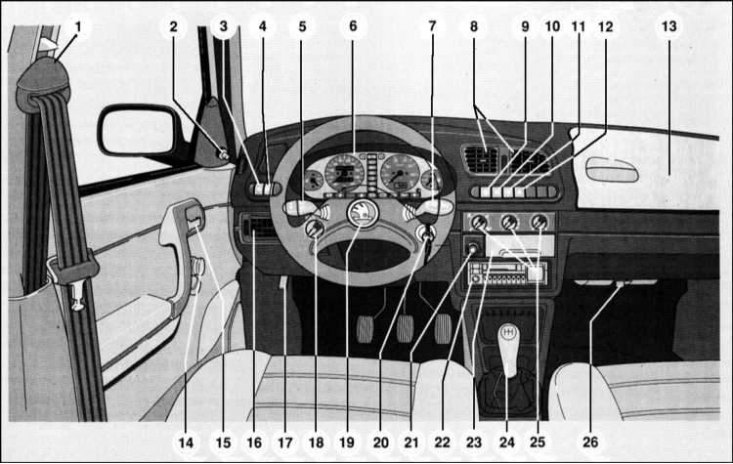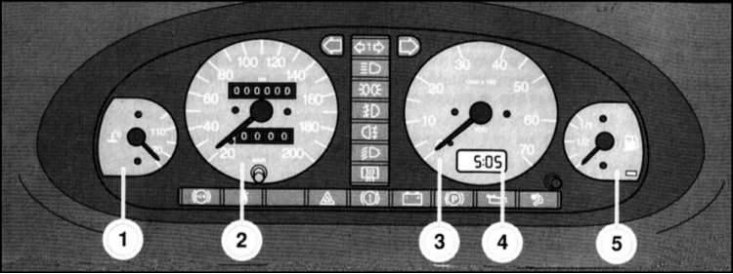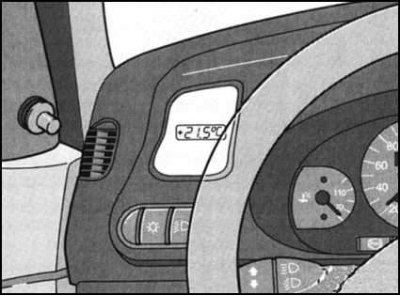
1 - Anchor assembly of the seat belt with height adjustment; 2 - Handle for adjusting the position of the outside rear-view mirror; 3 - Switch for position lights / instrument lighting; 4 - Low beam switch; 5 - Combined steering column switch for controlling the operation of direction indicators and turning on the high beam of the headlights; 6 - Instrument panel with a combination of instruments; 7 - Combined steering column switch for controlling the operation of wipers / windshield washers; 8 - Central deflectors of the air ducts of the heating / ventilation system of the cabin; 9 - Rear window heating switch; 10 - Fog lamp switch; 11 - Rear fog lights switch; 12 - Alarm switch; 13 - Glove box; 14 - Handle for controlling the operation of the window regulator; 15 - Internal door handle; 16 - Side deflectors of the air ducts of the heating / ventilation system of the cabin and blowing the side windows; 17 - Control lever for unlocking the hood lock; 18 - Switch for adjusting the position of the optical axis of the headlights; 19 - Horn button; 20 - Ignition lock / steering column lock; 21 - Cigarette lighter; 22 - Radio panel; 23 - Ashtray; 24 - Gearshift lever; 25 - Control panel for the functioning of the heating / ventilation system; 26 - Fuse and relay mounting block
Instrument cluster

1 - Coolant temperature meter; 2 - Speedometer with odometers; 3 - Tachometer / analog clock; 4 - Digital clock display; 5 - Fuel consumption meter
Note. The numbering given in the text corresponds to that shown in the illustration.
Coolant temperature meter (1)
The meter functions only when the ignition is on, taking the working position with some delay. When the coolant is cold, the arrow of the device is at the bottom of the scale. The normal operating temperature range is between 70°C and 110°C. In hot weather, or when the engine is under load, the coolant temperature may rise up to the upper limit of the normal operating range of the dial. However, in no case should the pointer of the meter be allowed to enter the red-colored section of the indicator scale. The transition of the arrow to the upper permissible value indicates that the engine is overheating. In this case, the car should be stopped and, without turning off the engine, turn on the heater and the heater fan at full power, then check the fluid level in the expansion tank of the cooling system and make sure that the radiator fan is working properly. If the fan does not function, or the liquid level in the expansion tank has fallen below the permissible value, the engine should be immediately turned off. If the liquid and the fan are in order, the movement can be continued, but only on condition that the pointer arrow has returned to the range of acceptable values. Otherwise, the engine must also be switched off.
If the coolant level is normal, the cause of the engine overheating may be a failure of the cooling fan. Check the condition of the relevant fuse and replace if necessary. If there is a failure of the fan electric motor, or the failure of its impeller, the movement after a while can be resumed (assuming the coolant level is correct), and the vehicle should be driven to the nearest service station. Due to the fact that with a faulty fan, the efficiency of the radiator will be determined only by the speed of the oncoming flow, you should try to move at a good speed (but not too high) speed, minimizing coasting.
Attention! The inclusion of additional headlights installed under the grille reduces the efficiency of the latter and can lead to overheating of the engine in hot weather or when driving with an increased load.
Speedometer/odometers (2)
The speedometer has an analog version. The unit of division of the dial scale is 10 km/h. In the upper half of the dial field there is a drum for the counter of the total mileage of the car from the moment it was released from the conveyor (odometer). The drum counter located under the arrow axis registers the mileage of the current trip. Resetting the current mileage counter is carried out using the handle mounted in the lower part of the speedometer dial.
Tachometer (3)
The device registers the engine speed at 1000 rpm. In no case do not allow the meter needle to enter the red sector of the dial scale. Remember that timely shifting to a higher gear helps to save fuel consumption and reduce the noise level of the power unit.
Avoid over-revving the engine during vehicle break-in.
Pointer clock (3)
On some models, instead of a tachometer, an analog clock is included in the instrument cluster. The time setting knob is located on the right under the clock face.
Attention! Do not be distracted while driving - set the time only in the parking lot!
Clock with digital display (4)
The digital clock display is mounted in the tachometer dial field. The time setting knob is located on the right under the meter block. Turning the knob counterclockwise selects the current hour, to set the minutes turn the knob to the right. When setting the time, try not to press the handle excessively in order to avoid failure of the regulator.
Attention! Do not be distracted while driving - set the time only in the parking lot!
Fuel consumption meter (5)
The meter is activated only when the ignition is on. The output of the arrow of the device in the working position occurs with a certain time delay. It should be remembered that the volume of the fuel tank for carburetor models is about 47 liters, for models equipped with a fuel injection system - only 42 liters.
Deviations in the readings of the meter and the short-term switching on of the fuel reserve warning lamp during maneuvers are associated with the movement of the fuel surface level in the tank and should not cause concern.
Constant inclusion of a control lamp testifies to the termination of a stock of fuel. At the same time, about 6 liters of fuel remain in the tank.
Ambient temperature meter

The digital display of the meter is mounted on the left side of the instrument panel. The measurement range lies in the range from -45°С to +50°С. The display of the actual value of the ambient air temperature is made with a delay of about 5 minutes. During parking or when driving at low speed, the meter readings may be slightly overestimated due to the effect on the sensor of heat generated by the engine.
Attention! Remember that ice can also occur at temperatures above 0°C!
